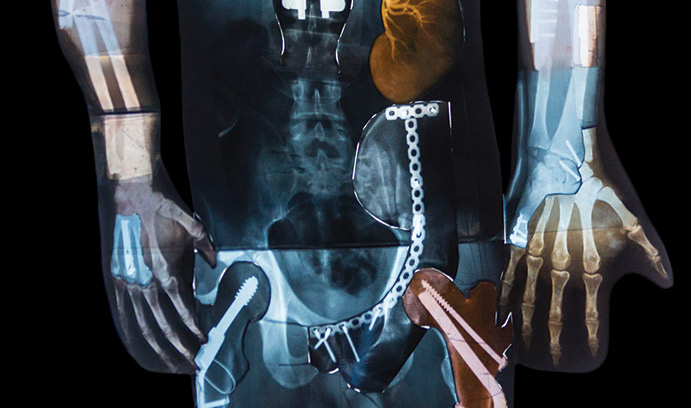Lehigh Researcher Develops Revolutionary Orthopedic Device

Hannah Dailey's novel orthopedic device may revolutionize bone fracture recovery, improving patient outcomes and reducing costs. It improves upon past treatments for bone fractures, as pictured here.
Healing Bone Faster
To heal small bone fractures—like those in a wrist, finger or ankle—a cast or splint is usually all that is needed to promote regrowth. Once stable, the bone tissue—a living material—regenerates and heals.
Healing a break in a long bone—like the femur (thigh bone) or tibia (shin bone)—is a more complicated and much lengthier process. It can take four to six months—sometimes even longer—for a patient to return to full use of their legs after a traumatic incident.
Since the 1940s, surgeons have used a process called intramedullary nailing to heal long bone breaks. During this procedure, a specially designed metal rod is inserted into the marrow canal of the bone. The rod passes across the fracture to keep it in position and is screwed to the bone at both ends. As the bone tissue regrows, the rod holds the bone in place, directing where and how new bone tissue forms.
Device design improvements have focused on the mechanical environment at the fracture site to accelerate bone remodeling.
"When it comes to bone healing, extremes of both stability and instability can have a detrimental effect," explains Hannah Dailey, assistant professor of mechanical engineering and mechanics. "My focus is on improving patient outcomes by designing a rod that optimizes healing through micro-motion—a device that creates the ideal conditions at the fracture site to promote maximum healing."
Research has shown that axial movement—the movement of the rod up and down inside the bone—speeds healing. Unfortunately, an increase in such movement has also been associated with increased twisting motion, which has been found to slow healing.
Dailey and her colleagues have developed a technology that achieves the ideal combination: increased axial motion that speeds healing with minimal torsional, or twisting, movement. The device is called a Flexible Axial Stimulation (FAST) intramedullary nail. Known commercially as the Apex Tibial Nail System from OrthoXel, FAST has the potential to revolutionize bone fracture recovery.
A revolution in orthopedic medicine is on the agenda at OrthoXel, the medical device start-up that Dailey co-founded and where she serves as Chief Scientific Officer. The company seeks to develop and commercialize orthopedic devices that improve patient outcomes, increase surgeon accuracy and efficiency, and reduce costs to patients and the health care system. The Apex Tibial Nail System is the first OrthoXel device to hit the market.
The device is the result of a five-year research and development process led by Dailey and colleagues at the Cork Institute of Technology in Ireland, who oversaw all aspects from conceptual ideation through a large-animal preclinical study.
She and her team undertook a proof of concept study that demonstrated support for the development of a micro-motion-enabled intramedullary nail. Notably, the study suggested that when compared to rigid-fixation nails—which require significant weight-bearing to induce the interfragmentary motion that promotes healing—the micromotion-enabled nail was likely to allow movement in non-weight bearing patients during the early healing period. The early recovery stage is when the benefits of mechanical stimulation at the fracture site are most critical.
Later, the team published the results of a comprehensive biomedical study showing that the device provided controlled axial motion at the fracture site while retaining high torsional stability—the ideal combination to enhance healing.
Finally, preclinical trials on the micro-motion-enabled tibial nails produced successful healing, and provided strong safety evidence in vivo—paving the way to the development of the commercial product now marketed to surgeons. The team is also working on an Apex Femoral Nail System to provide solutions for additional fracture types.
This story appears as "Healing Bone Faster" in the 2017 Lehigh Research Review.
Posted on:




